
|
The East India Company's first factory or trading post established in 1611 in Masulipatam on the southeastern coast was followed soon thereafter by a trading post
established in Surat, the principal Mughal port, in December 1612. In 1616, the company's Superintendent in Surat was given the title of President by his own staff, and this
led to the naming ultimately of the three big Company administrative units in Madras, Bombay and Bengal as Presidencies. The Bombay Presidency got a big boost in 1661
when, at the marriage of Princess Catherine of Portugal to Charles II of England, the King of Portugal gave as a gift the island of Bombay to the English king. He in turn
transferred the island to the EIC, which made Bombay their Indian headquarters in 1687.
The first English mint on the west coast was established at Bombay in 1672. The first coins were European in style, featuring the Company's coat of arms and legends in Roman
letters. These coins did not circulate widely and for trade the Company had to take silver to the Mughal mint at Surat to be coined. Finally, in 1717, the emperor Farrikhsiyar
granted the Company the right to mint coins in the Mughal style. Gold and silver coins in the Mughal idiom were struck from 1717 until the introduction of the unified coinage in
1835. The base metal coinage, in copper and tin, was struck in the Company's own designs.
|
 |
Bombay Presidency |
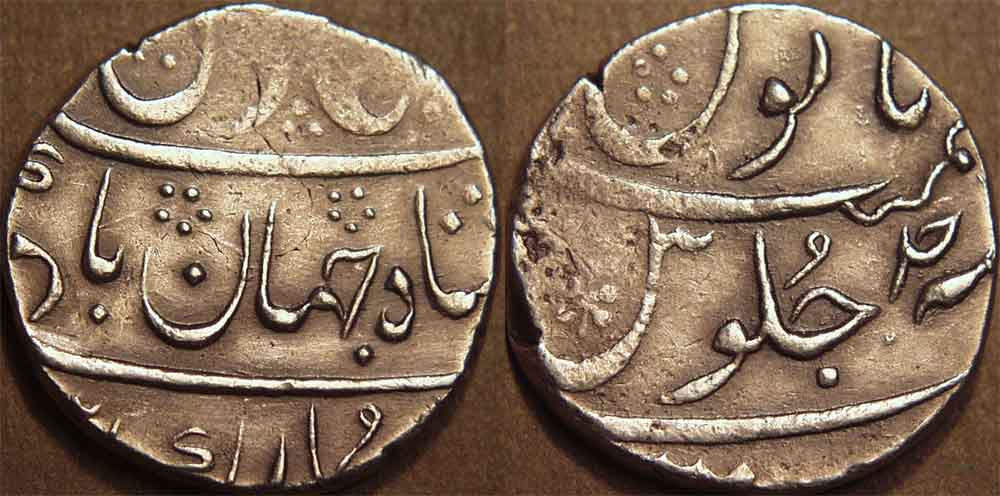
|
Silver rupee in name of Shah Jahan II, Munbai, AH 1131, year 1 (1719)
Weight: 11.51 gm. Diameter: 25 mm Die axis: 3 o'clock
Legend, including AH date (113)1, RY 1 (ahd)
Legend, including sunburst mintmark
Reference: Pridmore 32, KM P32, MNI 1692
|
 |
Rafi ud-Daulah Shah Jahan II was Mughal emperor for just a few months in 1719.
|
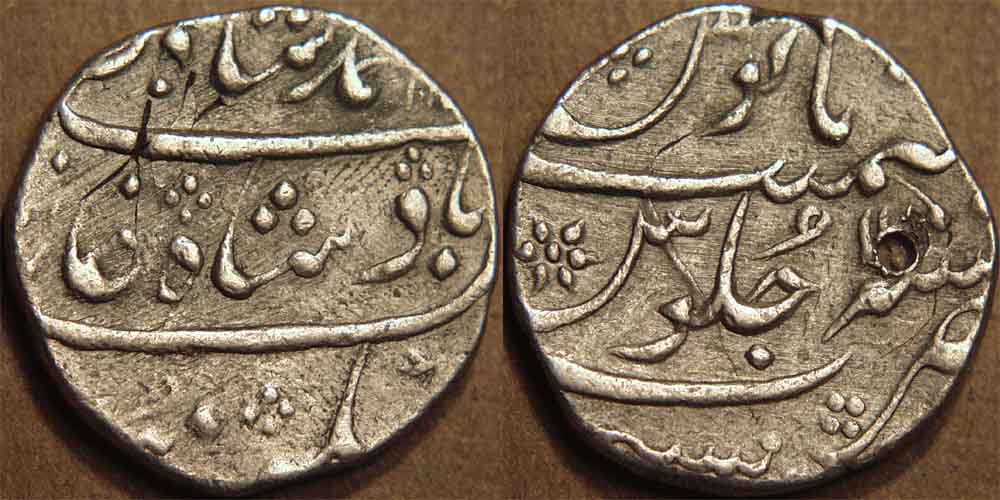
|
Silver rupee in the name of Muhammad Shah (1719-1748), Munbai, RY 12
Weight: 11.46 gm. Diameter: 25 mm Die axis: 11 o'clock
Legend, naming Muhammad Shah, including AH date 11xx (1142)
Legend, including mint name Munbai, mintmark sunburst or
6-petalled flower without stem, and regnal year 12
Reference: Pridmore 44, KM 163, MNI 1696 var
|
 |
The six-petalled flower without stem was the mintmark for Bombay during 1729-33.
|

|
Silver rupee in the name of Muhammad Shah (1719-1748), Munbai, RY 24
Weight: 11.17 gm. Diameter: 22 mm Die axis: 2 o'clock
Legend, naming Muhammad Shah, including AH date 1153 (=1740-41 CE)
Legend, including mint name Munbai, mintmark 5-petalled flower
with stem, and regnal year 24
Reference: Pridmore ---, KM --- (unlisted)
|
 |
The five-petalled flower with stem became the mintmark for Bombay in 1735. This year is unlisted in Pridmore or KM.
|
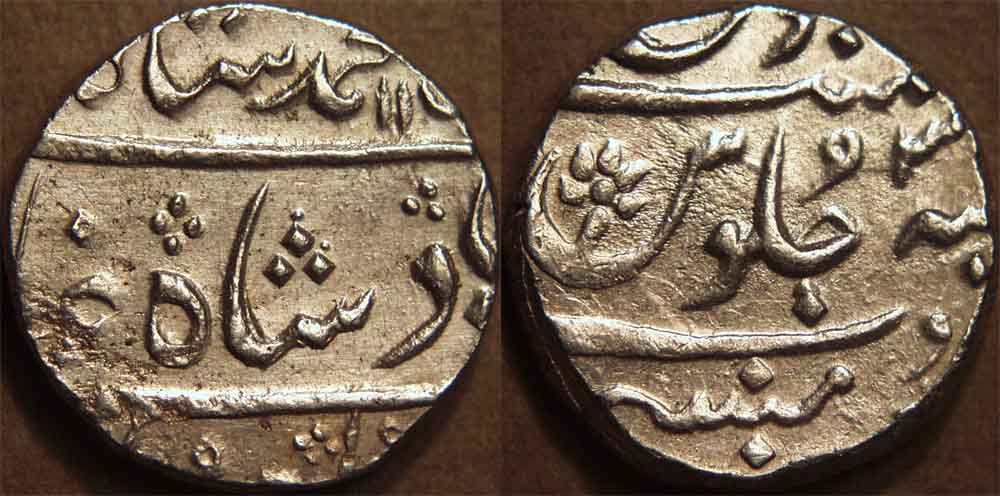
|
Silver rupee in the name of Muhammad Shah (1719-1748), Munbai, RY 31
Weight: 11.54 gm. Diameter: 22 mm Die axis: 8 o'clock
Legend, naming Muhammad Shah, including AH date 116(1) (=1748-49 CE)
Legend, including mint name Munbai, mintmark 5-petalled flower
with stem, and regnal year 3(1)
Reference: Pridmore 56, KM 163, MNI 1696 var
|
 |
This coin is from the last year of Muhammad Shah's reign and, according to Pridmore, was actually struck after the Emperor's death.
|
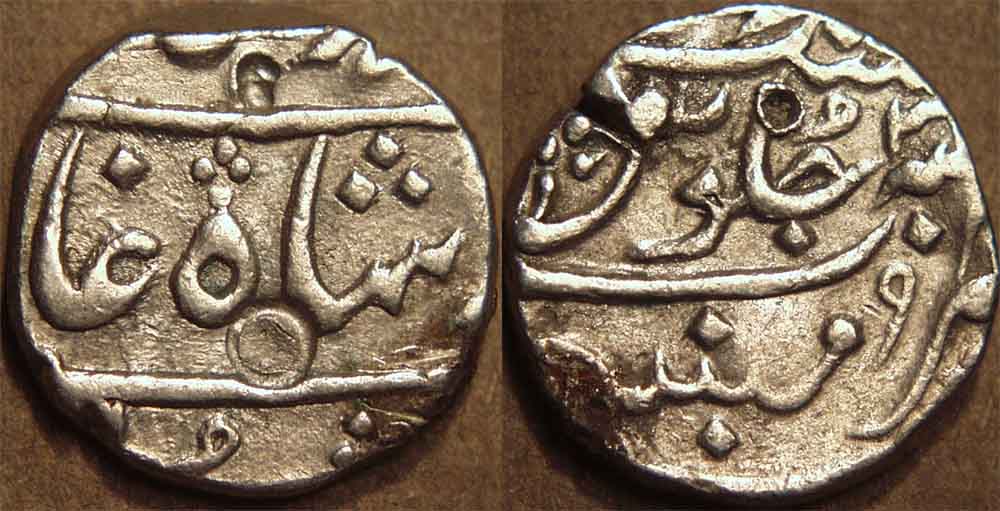
|
Silver half rupee in the name of Muhammad Shah (1719-1748), Munbai, RY 31
Weight: 5.65 gm. Diameter: 18 mm Die axis: 1 o'clock
Legend, naming Muhammad Shah
Legend, including mint name Munbai, mintmark 5-petalled flower
with stem, and regnal year 3(1)
Reference: Pridmore ---, KM --- (unlisted)
|
 |
The half rupees are much scarcer than the full rupees, and this year unlisted in Pridmore and KM.
|
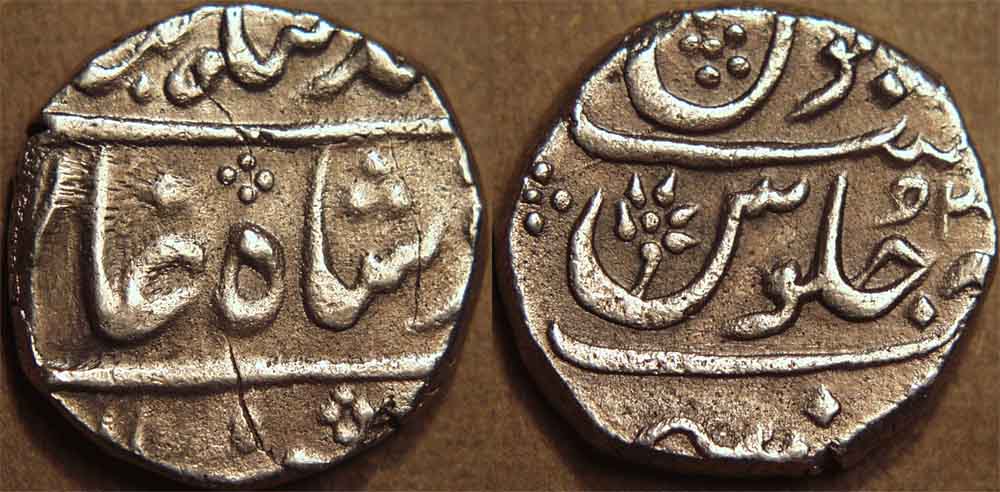
|
Silver rupee in the name of Ahmad Shah Bahadur (1748-1754), Munbai, RY 2
Weight: 11.37 gm. Diameter: 21-22 mm Die axis: 9 o'clock
Legend, naming Ahmad Shah Bahadur, AH date 1163 off flan
Legend, including mint name Munbai, mintmark 5-petalled flower
with stem, and regnal year 2
Reference: Pridmore ---, KM --- (unlisted)
|
 |
This year is unlisted in Pridmore or KM.
|
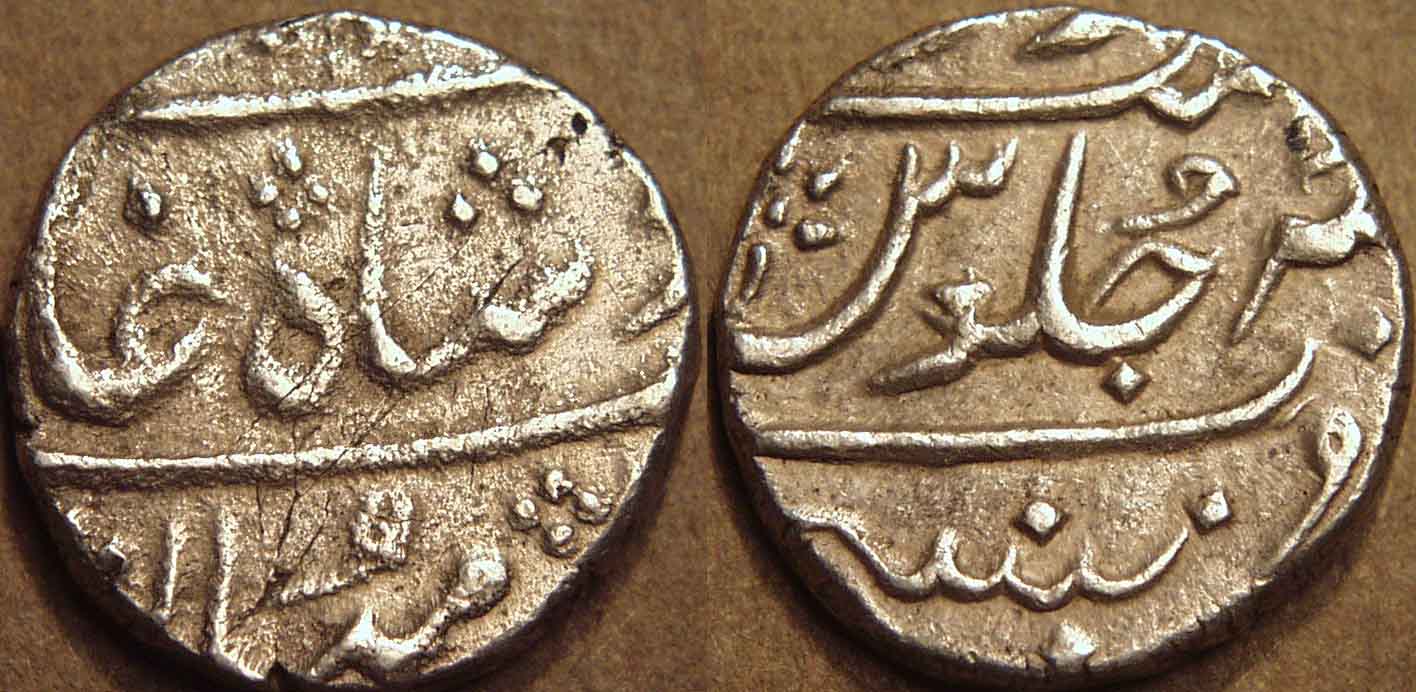
|
Silver half rupee in the name of Ahmad Shah Bahadur (1748-1754),
or Alamgir II (1754-1759), Munbai, RY 2
Weight: 5.65 gm. Diameter: 19 mm Die axis: 3 o'clock
Legend, ruler's name off the flan
Legend, including mint name Munbai, mintmark 5-petalled flower
with stem, and regnal year 4
Reference: Pridmore ---, KM --- (unlisted)
|
 |
The ruler's name is unfortunately off the flan on this coin, but we do see a RY 4 on the reverse. The coin cannot be in the name of
Muhammad Shah, as the five-petalled flower Daroga mark seen on it came into use only in RY 17 of Muhammad Shah. It must therefore belong to the reign of Ahmad Shah or
Alamgir II. Neither Pridmore nor KM show a RY 4 half rupee for either ruler, although apparently the coins are known.
|
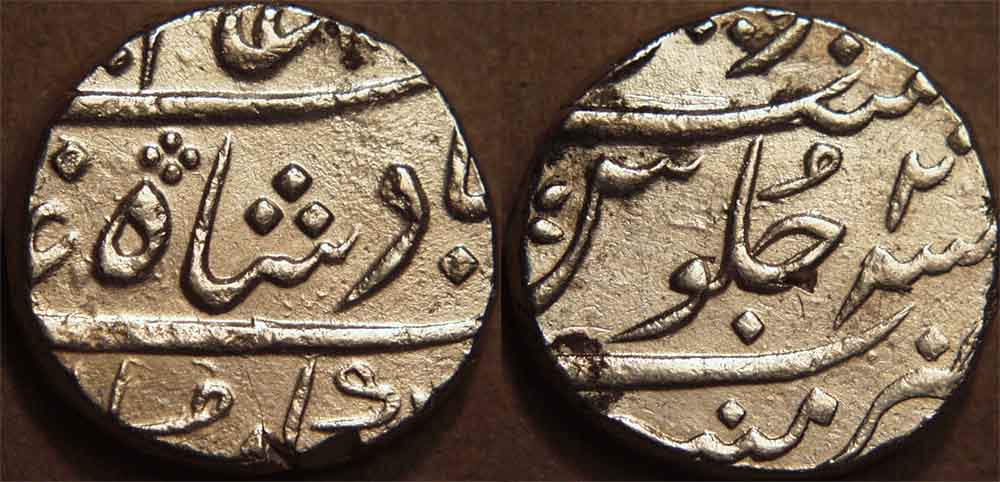
|
Silver rupee in the name of Alamgir II (1754-1759), Munbai, RY 2
Weight: 11.56 gm. Diameter: 21 mm Die axis: 12 o'clock
Legend, naming 'Alamgir II
Legend, including mint name Munbai, mintmark 5-petalled flower
with stem, and regnal year 2
Reference: Pridmore 68-69, KM 176
|
 |
The five-petalled flower with stem became the mintmark for Bombay in 1735 during the reign of Muhammad Shah, and was continued
in the reigns of Ahmad Shah Bahadur and 'Alamgir II.
|
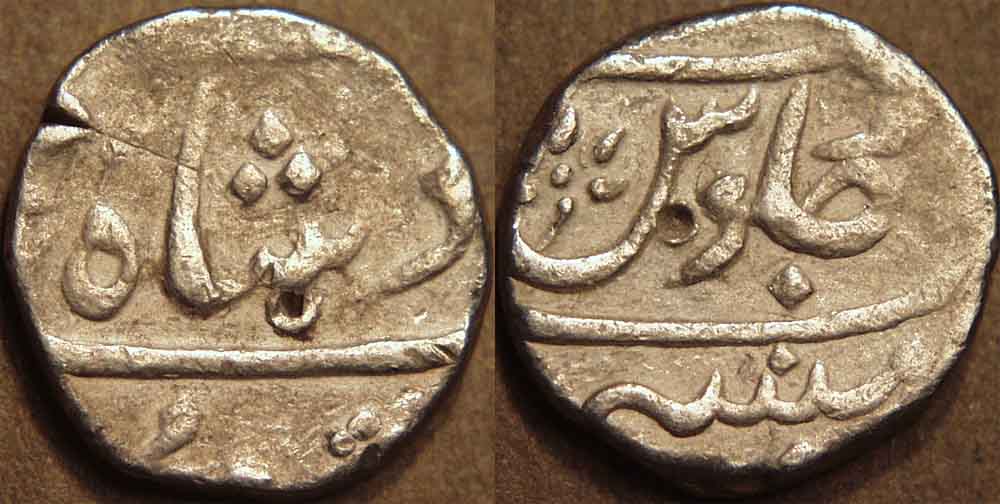
|
Silver half rupee in the name of Alamgir II (1754-1759), Munbai, RY 5
Weight: 5.75 gm. Diameter: 17 mm Die axis: 11 o'clock
Legend, naming 'Alamgir II
Legend, including mint name Munbai, mintmark 5-petalled flower
with stem, and regnal year 5
Reference: Pridmore 72, KM 175
|
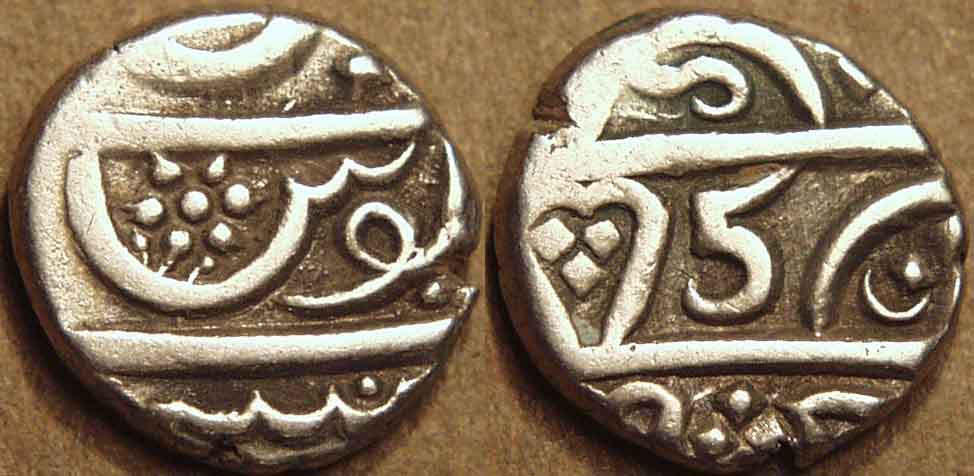
|
Silver 1/5 rupee (velli fanam, "Bombay billy") in the name of
Alamgir II (1754-1759), Malabar
Weight: 2.22 gm. Diameter: 12 mm Die axis: 10 o'clock
Legend, naming 'Alamgir II
Legend, including inverted 5
Reference: Pridmore 295, KM C621, MNI 1744 var
|
 |
Originally minted in Bombay, the one-fifth rupee ("Bombay Billy") was later minted at Cannanore, as was this coin, even while naming
Bombay as the mint. Cannanore was within the Bombay Presidency. Note the inverted 5 to represent the denomination ... the "inverse of 5" rupee.
|
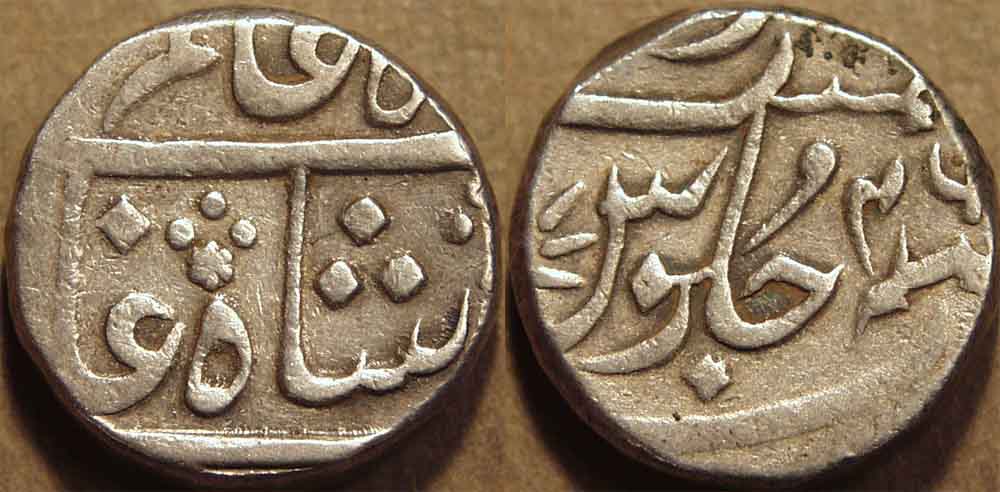
|
Silver rupee in the name of Shah Alam II (1759-1806), Bombay, 1803-24
Weight: 11.56 gm. Diameter: 19 mm Die axis: 10 o'clock
Legend, naming Shah Alam, and flower or star privy mark of Bombay
Legend, including regnal year 46
Reference: Pridmore 270, KM 664
|
 |
Although this coin lists a regnal year of 46, which corresponds to the year 1803-04, it may have been issued in any year from 1803 to
1824, since the year 46 became a frozen year on this Surat type coinage. Pridmore and Mitchiner say the coin could have been issued from 1800-24, the period when the
minting had been moved from Surat to Bombay, but before the 1825 types were introduced. However, it sems to me that an issue during 1800-02 can be ruled out, as those
years preceded Shah Alam's RY 46. Note the flower or star privy mark as the lowest of the four dots in the center of the obverse.
|
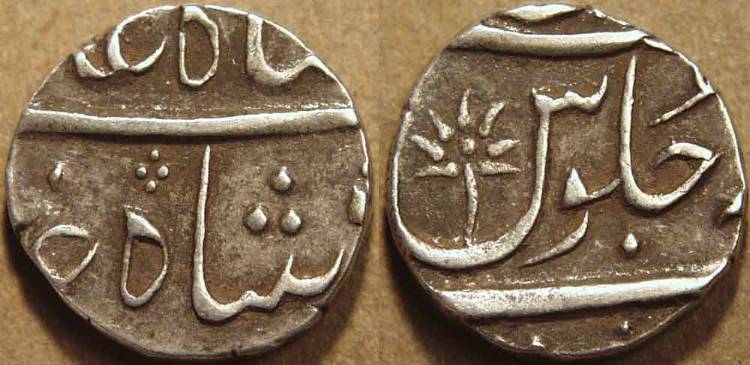
|
Silver half rupee in the name of Shah Alam II (1759-1806), Surat, c. 1800-15
Weight: 5.72 gm. Diameter: 17 mm Die axis: 4 o'clock
Legend, naming Shah Alam, and with 4-dot privy mark of Surat
Legend, including Surat mark 7-petalled flower with stem
Reference: Pridmore 254, KM 211.1
|
 |
The British continued the marks used by the Nawabs of Surat, but the 7-petalled flower underwent a subtle transformation.
|
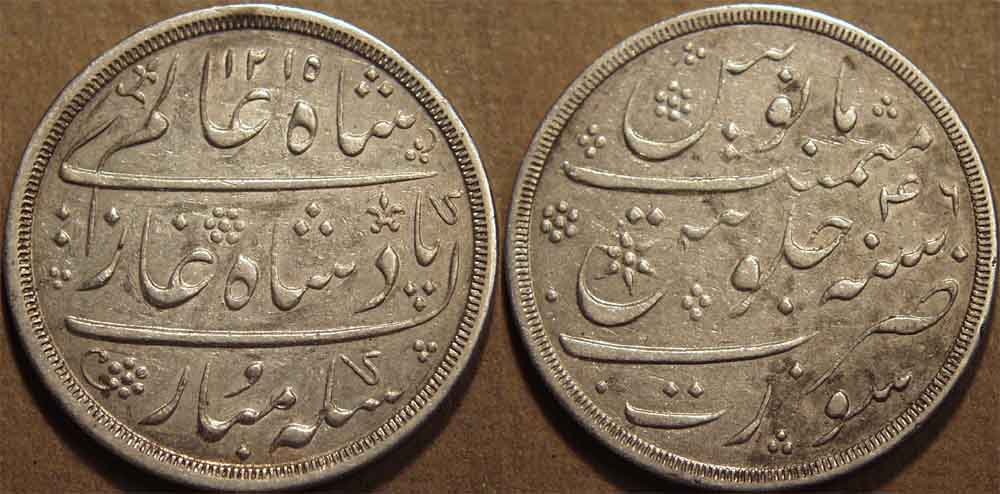
|
Silver rupee in the name of Shah Alam II (1759-1806), Bombay, 1832-35
Weight: 11.62 gm. Diameter: 28 mm Die axis: 7 o'clock
Legend, naming Shah Alam II and listing AH date 1215
Legend, including mint name Surat, mintmark 5-petalled flower with stem
and regnal year 46
Reference: Pridmore 286, KM 678a
|
 |
This is one of India's first machine-made coins ... the first issue of the new Bombay mint, which commenced operations in 1832 and
continues to this date. The coin is full of fictions. Issued in the years 1832-35, it lists as the date AH 1215, which corresponds to the years 1800-01! It is issued in the name of
Shah Alam II, who had died in 1806, and lists his regnal year of 46, which corresponds to AH years 1217-18, thus conflicting with the listed AH date of 1215! Finally, it names as
its mint Surat, even though it was actually issued in Bombay! All of these fictions are so appropriate for a coin issued in the name of a puppet Mughal emperor by a powerful
colonial power, whose presence is formally indicated only by the 5-petalled flower at left on the reverse!
|
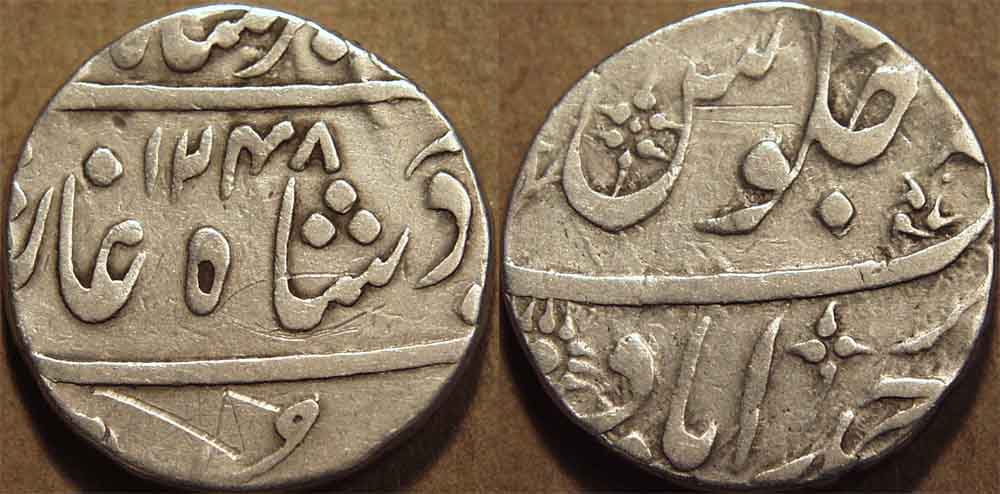
|
Silver rupee in the name of Muhammad Akbar II (1806-1837),
Ahmedabad, AH 1248
Weight: 10.62 gm. Diameter: 22 mm Die axis: 12 o'clock
Legend, naming Muhammad Akbar, and with AH date 1248 (= 1832-33 CE)
Legend, including mint name Ahmedabad, British mark 5-petalled flower with stem
and "Maratha" mintmark of a sunburst at bottom left
Reference: Pridmore --- (unlisted), KM 45
|
 |
The British annexed Ahmedabad from the Gaekwar of Baroda in 1817 and continued to issue coins from that city until 1835, following
on the previous patterns. They introduced the five-petalled flower with stem, but retained the "Maratha" mintmark of a sun with rays extending in four directions. This may be the
only type issued by the British in the name of Muhammad Akbar II, as they continued issuing fictitious coins of year 46 of Shah Alam at their other mints.
|
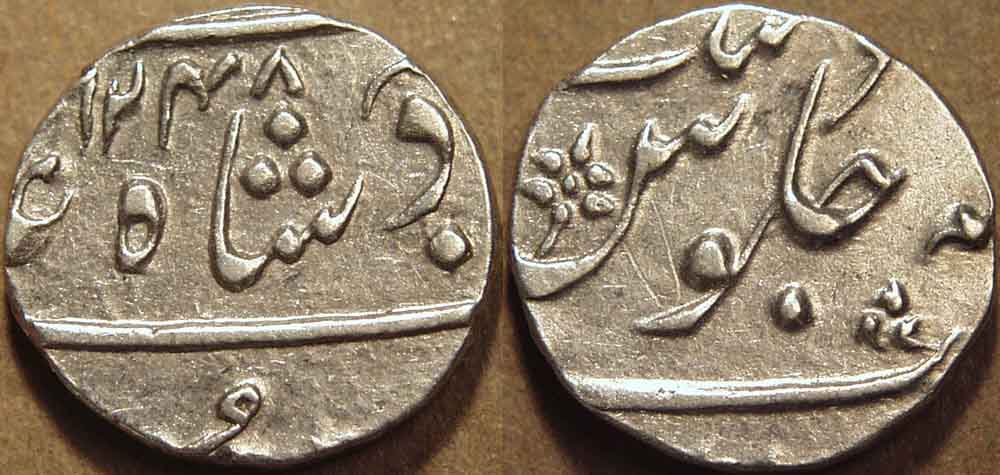
|
Silver half rupee in the name of Muhammad Akbar II (1806-1837),
Ahmedabad, AH 1248
Weight: 5.83 gm. Diameter: 17-18 mm Die axis: 6 o'clock
Legend, naming Muhammad Akbar, and with AH date 1248 in the middle register
Legend, including mint name Ahmedabad, British mark 5-petalled flower with stem
Reference: Pridmore --- (unlisted), KM --- (see KM 45 for rupee)
|
 |
Unlisted in Pridmore or KM. Note that the AH date is in the middle register of the obverse.
|
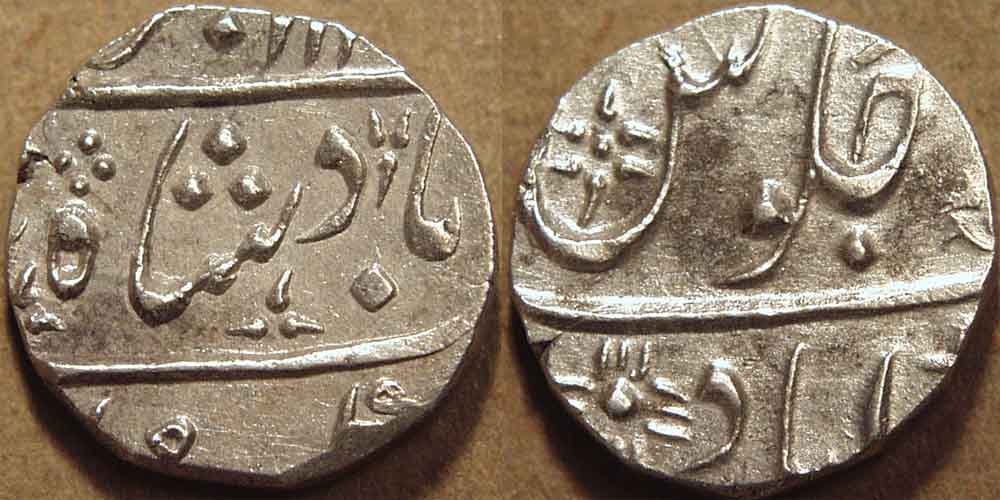
|
Silver half rupee in the name of Muhammad Akbar II (1806-1837),
Ahmedabad, c. AH 1248
Weight: 5.79 gm. Diameter: 17-18 mm Die axis: 5 o'clock
Legend, naming Muhammad Akbar, and with AH date in the middle register
Legend, including mint name Ahmedabad, British mark 5-petalled flower with stem
and "Maratha" mintmark of a sunburst at bottom left
Reference: Pridmore --- (unlisted), KM --- (see KM 45 for rupee)
|
 |
Unlisted in Pridmore or KM. Note that the AH date (not fully seen) is in the top register of the obverse.
|
|
|